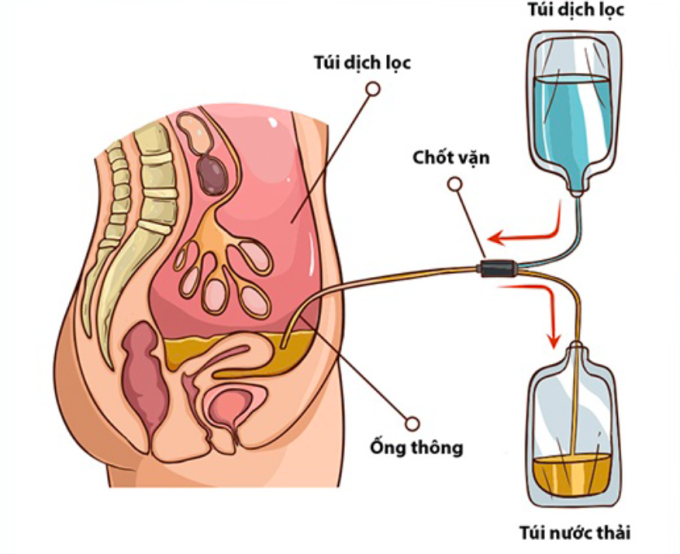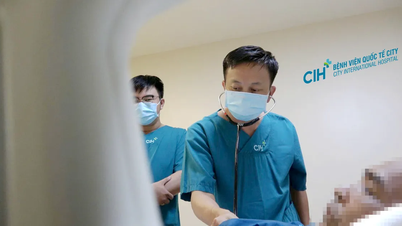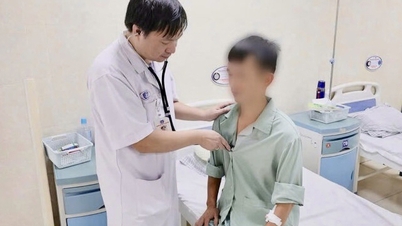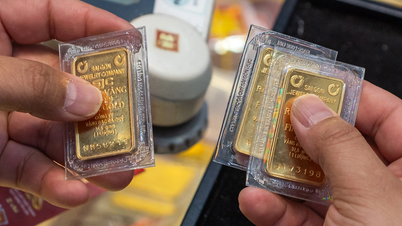Kidney failure patients can filter their blood at home using peritoneal dialysis during the Tet holiday.
Dr. Nguyen Thi Thanh Thuy, Department of Nephrology - Dialysis, Center for Urology - Nephrology - Andrology, Tam Anh General Hospital, Ho Chi Minh City, said that peritoneal dialysis uses the peritoneal membrane to filter waste and excess fluid to replace the impaired kidney function.
One of the advantages of peritoneal dialysis is that patients can do it themselves at home, suitable for patients who live far away or do not have the conditions to go to the hospital regularly. To perform this method, the patient has a catheter (peritoneal dialysis catheter) surgically placed on the abdomen at least two weeks in advance.
There are two methods of peritoneal dialysis: machine peritoneal dialysis and manual peritoneal dialysis. The implementation for each specific method is as follows:
Peritoneal dialysis:
- Wash your hands thoroughly with soap.
- Install the dialysis tubing (including 6 tubes) into the peritoneal dialysis machine, close all clamps on the tube bodies.
- Place the infusion bags (the number of infusion bags and the concentration of the fluid depends on each patient's indication) near the peritoneal dialysis machine, and place the drainage bags on the ground.
- Open the clamp, connect the discharge hose (the rightmost hose in the hose set) to the discharge bag and press the machine start button.
- Wash your hands again.
- Open the clamps on the fluid supply lines and connect them to the fluid bags.
- Wait for the machine to check the patient's wire (leftmost wire), then connect this wire to the catheter on the patient's abdomen, being careful not to touch the connection head (transfer set).
- Press the machine operation button.

Illustration of peritoneal dialysis. Photo: Provided by the hospital
Manual peritoneal dialysis:
- Wash your hands with soap, wipe the table where the fluid bag is placed with medical alcohol.
- Prepare the necessary tools including two specialized clamps (green clamps), one minicap (cap to cover the end of the connecting tube in peritoneal dialysis), peel off the fluid bag and place the fluid bag, green clamps, and minicap on the table.
- Wear a mask, wash and dry your hands.
- Check the fluid bag, separate the two bags and two wires.
- Use the green clip on the wire to put the liquid into the clean water bag, break the green safety lock of the bag.
- Hang the fluid bag on a hook and place the empty bag on the ground.
- Take the adapter out of the clothing, check and make sure the adapter is locked.
- Wash your hands with antiseptic solution or medical alcohol.
- Use your non-dominant hand to hold the end of the fluid bag, use your dominant hand to hold the pull ring cap, pull the pull ring off the fluid bag, and drop the cap to the ground. Use your dominant hand to hold the adapter, and use your other hand to open the minicap off the adapter.
- Connect the adapter to the fluid bag, turn the white knob inside to open it to drain the soaked fluid in the stomach down to the bag below until it is gone, then close the twist lock again.
- Remove the green clamp on the inlet line, count to 5 to release the air in the bag, then clamp the outlet line again.
- Open the rotation lock to let new fluid into the abdomen, then close it when all the new fluid has entered. Use the remaining green clamp to clamp the fluid line.
- Wash your hands with antiseptic solution or medical alcohol. Open the new minicap packaging and check if the cotton inside the cap is still wet with antiseptic solution.
- Disconnect the adapter from the double bag, put on the new minicap, and insert the tubing into the bag.
- Check the discharged fluid, weigh the discharged fluid, record the amount of fluid in or out and its color.
- Cut the corner of the drainage bag, empty and throw away the bag, keep the green clip. Clean and sanitize the table, green clip, towel and the drainage area.
Dr. Thanh Thuy recommends that although peritoneal dialysis is simple, in order to be able to do it at home, the patient and family must be instructed by a doctor and practice it thoroughly. In addition, people with kidney failure need to periodically go to the hospital for check-ups according to the doctor's appointment to monitor the condition of the disease.
During the process of self-peritoneal dialysis at home, if infection, low blood pressure, hypothermia, heart rhythm disturbance, fluid leakage from the abdomen, catheter prolapse, bleeding at the catheter site... are detected, the patient must go to the hospital immediately.
Thang Vu
Source link


![[Photo] Panorama of the cable-stayed bridge, the final bottleneck of the Ben Luc-Long Thanh expressway](https://vphoto.vietnam.vn/thumb/1200x675/vietnam/resource/IMAGE/2025/9/30/391fdf21025541d6b2f092e49a17243f)
![[Photo] The 1st Congress of Phu Tho Provincial Party Committee, term 2025-2030](https://vphoto.vietnam.vn/thumb/1200x675/vietnam/resource/IMAGE/2025/9/30/1507da06216649bba8a1ce6251816820)

![[Photo] Solemn opening of the 12th Military Party Congress for the 2025-2030 term](https://vphoto.vietnam.vn/thumb/1200x675/vietnam/resource/IMAGE/2025/9/30/2cd383b3130d41a1a4b5ace0d5eb989d)
![[Photo] President Luong Cuong receives President of the Cuban National Assembly Esteban Lazo Hernandez](https://vphoto.vietnam.vn/thumb/1200x675/vietnam/resource/IMAGE/2025/9/30/4d38932911c24f6ea1936252bd5427fa)



































































































Comment (0)